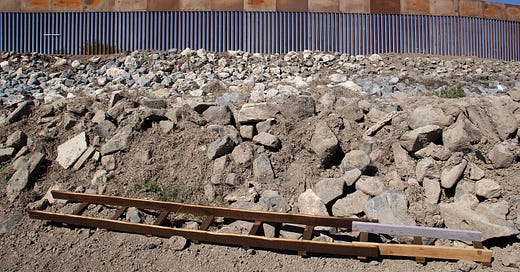Welcome to Just Two Things, which I try to publish daily, five days a week. Some links may also appear on my blog from time to time. Links to the main articles are in cross-heads as well as the story.
#1: Walls, borders, and ladders
Scott Nicol is an artist and activist based in Texas who has taken it upon himself to document the ladders used by migrants to climb a section of the border wall near to his home.
That section of the wall cost $27 million a mile to build. The ladders cost $5 to make.
On a cool and overcast day in early April, Nicol has centered his hunt on an eight-mile stretch of border between the towns of Hidalgo and Granjeno, where an Obama-era wall meets up with a newly constructed piece of Trump’s wall... Within minutes, Nicol has spotted a ladder roughly halfway up the levee; it’s about a dozen feet long and has only six rungs. “It’s made of cheap, rough wood, quickly nailed together because it is only going to be used once,” Nicol says. “Unlike the wall, these ladders are functional.”
You can insert your own metaphor here, of course.
(At a newly built section of border wall at Granjeno. Image: Scott Nicol, via Texas Monthly)
Nicol is interested in the ladders because they expose the inconsistencies—even irrationalities—of immigration policing. The Texas Monthly reporter Aaron Nelson and Scott Nicol are there when a group of asylum seekers emerge from the brush and hand themselves over to border agents who escort them through a gate in the wall for processing. It’s the illegal immigrants who use the ladders:
“That’s from our regulars,” one agent quips over his shoulder.
On other parts of the wall, rope ladders are preferred. On this section, wooden ladders work because there is cover close to the wall and they only need to be carried a short distance across open ground. They are cheaply made because they are designed to be used only once. When the border agents find them, they drive their vehicles over them to ensure they are broken.
The ritual perhaps underlines the extent to which the border wall, built up in parts over the Bush, Obama, and Trump presidencies, and still full of gaps, is more about rhetoric than function. The migrants keep coming—the numbers are up, and Nicol says he’s finding more ladders—the agents can’t really deal with the numbers, and the only people who benefit are the contractors who have built the new sections of fence:
Despite securing about $6 billion in funding from Congress and diverting nearly $10 billion more from the Department of Defense budget, the Trump administration managed to complete only forty miles of “big, beautiful wall,” about twenty of them in the Rio Grande Valley. One of its unfinished projects can be found in Granjeno, where a section of levee wall (with no fencing on top) built during the Obama years abruptly ends at the edge of this no-stoplight town... But contractors didn’t manage to finish installing all of the bollards before President Joe Biden paused construction. Situated at the base of the incomplete Trump wall is Cabrera’s Bar, an open-air watering hole.
Lupe, who runs the bar, has his own collection of photos of ladders on his mobile phone. As Aaron Nelson notes,
After Biden paused construction in late January, leaving a gap in the wall by the bar, some contractors kept on stopping by for a drink. “These guys are making money whether they build or not,” Lupe said of the contractors, “but really, what good is a wall if they don’t change immigration policy?”
#2: The trouble with plastic
Industry lobbying groups are masters of partial representation, so it was a pleasure to read the scepticism in a Core 77 piece on a piece of promotion by the Spanish plastics industry. ‘Stunt’ was the word they used.
The stunt was this:
The Museum of Plastic, a temporary structure made out of you-know-what, erected outside of Spain's National Museum in Madrid. Its projected lifespan is just ten days; opened last Saturday, it's due to be torn down on May 17th--World Recycling Day--and recycled in its entirety, to remind the public that, yinno, plastic is recyclable.
Core 77’s complaint about this is this:
Plastic is a wonderful material, and it's wonderful that it's technically recyclable. The problem is that the vast majority of plastic is never recycled. According to National Geographic, citing a global study from the peer-reviewed journal Science Advances, just 9% of plastic gets recycled.... So both worldwide and in the U.S., the actual non-recycling rate of plastic is greater than 90%. If there was a car model that, more than 9 times out of 10, failed to safely convey its occupants to their destination, no one would call that car safe.
Of course, the Museum of Plastic’s plastic is certain to be recycled, because that’s the whole point of the thing. But you can’t help but think that the industry would be better if it used World Recycling Day to start increasing the miserable proportion of plastics that get recycled.
But if you think I’m being unfair here, you can watch the short Museum of Plastic video, in Spanish with English subtitles:
j2t#097
If you are enjoying Just Two Things, please do send it on to a friend or colleague.



